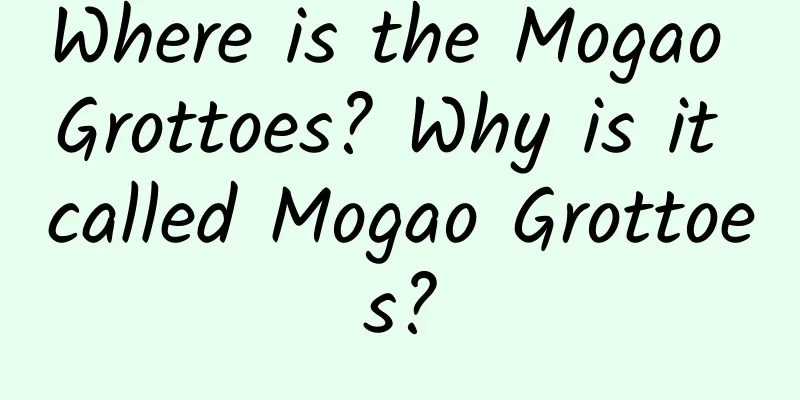Where is the Mogao Grottoes? Why is it called Mogao Grottoes?

|
The mysterious Mogao Grottoes are worth a visit. The statues in the Mogao Grottoes are all Buddhist gods and Buddhas, arranged in various combinations such as single statues and group statues. The group statues usually have the Buddha in the middle, with disciples and Bodhisattvas standing on both sides, with at least 3 and as many as 11. The colored sculptures are in the form of round sculptures, relief sculptures, and good deeds sculptures. These statues are exquisite and lifelike, with rich imagination and high attainments, and they are integrated with the murals and complement each other. So where is the Mogao Grottoes? Why is it called Mogao Grottoes? Let's take a look at the introduction of the Encyclopedia Knowledge Network! Contents of this article 1. Where is Mogao Grottoes? 2. Why is it called Mogao Grottoes? 3. What is the other cave between Mogao Grottoes and Longmen Grottoes? 1Where is Mogao Grottoes?Dunhuang City, Gansu Province. Mogao Grottoes, commonly known as the Thousand Buddha Caves, is located in Dunhuang at the western end of the Hexi Corridor. It was first built in the Former Qin period of the Sixteen Kingdoms, and has been built over the Sixteen Kingdoms, Northern Dynasties, Sui, Tang, Five Dynasties, Western Xia, Yuan and other dynasties, forming a huge scale with 735 caves, 45,000 square meters of murals, and 2,415 clay sculptures. It is the largest and most content-rich Buddhist art site in the world. In 1961, the Mogao Grottoes were announced by the State Council of the People's Republic of China as one of the first batch of national key cultural relics protection sites. In 1987, the Mogao Grottoes were listed as a World Cultural Heritage. Mogao Grottoes are known as the four major grottoes in China together with the Yungang Grottoes in Datong, Shanxi, the Longmen Grottoes in Luoyang, Henan, and the Maijishan Grottoes in Tianshui, Gansu. 2Why is it called Mogao Grottoes?Mogao Grottoes were built on the cliffs at the eastern foot of Mingsha Mountain, surrounded by a vast desert. Its terrain is nearly 100 meters higher than the Dunhuang Oasis, and is also known as the Thousand Buddha Mountain. Because the word "mo" for desert in ancient Chinese and the word "mo" for Mogao Grottoes are interchangeable, the grottoes excavated in the high desert were called Mogao Grottoes, which later evolved into Mogao Grottoes. The soil of the cliff where the Mogao Grottoes are located is relatively soft and not suitable for making stone sculptures. Therefore, except for the four large Buddha statues, which are stone-based clay sculptures, the rest of the statues in the Mogao Grottoes are wood-framed clay sculptures. The statues are all Buddhist gods and Buddhas, arranged in various combinations such as single statues and group statues. The group statues generally have the Buddha in the center, with disciples and Bodhisattvas standing on both sides, with at least 3 and as many as 11. The colored sculptures are in the form of round sculptures, relief sculptures, and good deeds sculptures. These statues are exquisite and lifelike, rich in imagination, and extremely accomplished. They are integrated with the murals and complement each other. 3What is the other cave between Mogao Grottoes and Longmen Grottoes?Yungang Grottoes. The Yungang Grottoes are located at the southern foot of Wuzhou Mountain, 17 kilometers west of Datong City, Shanxi Province, in northern China. The grottoes were carved into the mountain and stretch for 1 kilometer from east to west. There are 45 main caves, 252 caves of various sizes, and more than 51,000 stone sculptures. It is one of the largest ancient grottoes in China, and is known as one of the four major grotto art treasures in China, along with the Mogao Grottoes in Dunhuang, the Longmen Grottoes in Luoyang, and the Maijishan Grottoes in Tianshui. In 1961, it was announced by the State Council as the first batch of national key cultural relics protection units, and on December 14, 2001, it was listed as a World Heritage Site by UNESCO, and on May 8, 2007, it was rated as the first batch of national 5A-level tourist attractions by the National Tourism Administration. |
>>: Where is the Mogao Grottoes in Dunhuang? What is the history and culture of the Mogao Grottoes?
Recommend
Reasons for delayed menstruation
A woman's menstrual cycle is usually twenty-e...
What is the reason for the fishy smell and yellow leucorrhea
For friends who have symptoms such as fishy, sm...
Two lines were detected after 5 days of intercourse
If a woman has sex during her ovulation period, i...
What are the exercises for women to tighten their vagina?
As women age, their functions in all aspects will...
What are the benefits of drinking brown sugar water every day for women
Nowadays, people's living conditions are gett...
How many months is the legal breastfeeding period?
It will be more difficult for working women to ha...
Will taking folic acid affect menstruation?
Physical health is an important aspect for many p...
Is the pregnancy test accurate if the period is delayed by 1 day?
If your period is delayed by one day, you can tes...
Can I eat mint leaves while breastfeeding?
Can you drink mint tea during breastfeeding? Rega...
In which direction is the fetus' head facing at 5 months of pregnancy? In what position is the fetus' head at 5 months of pregnancy?
We all know that after a woman becomes pregnant, ...
What to do if female chest veins pop up
There are many reasons why women's chest vein...
What is the cause of the stringy leucorrhea?
Female friends must pay more attention to your le...
No symptoms in the early stages of infection? Here’s what you need to know about AIDS!
Do you know where the name of the dreaded disease...
Can I take Qilin Pills if I have amenorrhea?
Qilin Pills is the name of a Chinese medicine pre...
Can you get pregnant with multiple ovarian cysts?
In my life, there are many women suffering from o...









